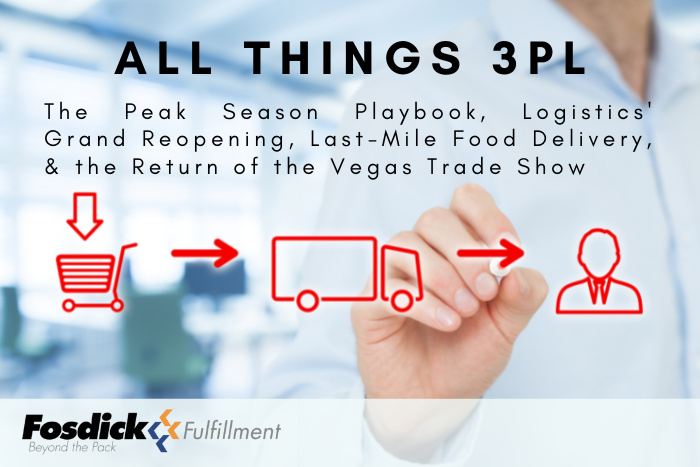The Peak Season Playbook, Logistics’ Grand Reopening, Last-Mile Food Delivery, & the Return of the Vegas Trade Show
Third-Party Logistics Peak Season in the Post-COVID World – 3PL Central
The Peak Season Playbook is a guide for third-party logistics (3PL) companies to prepare for peak season. The guide includes how to improve operations and understand what activities make money. 3PLs need to be nimble and vigilant with their efforts to meet and fulfill customer needs during peak season, especially during the holiday season.
3PLs have pushed innovation but failed to make positive change in the right direction, says Jodie O’Neill. 3PLs need to take advantage of ecommerce growth and be prepared for peak season, she says.
Customers value transparency and trust is the backbone to a long history of good communication, she adds. She says ‘s can also improve visibility and identify possible flaws in their technology.
Logistics Braces for the ‘Grand Reopening’ — But Will Workers Show Up? – Supply Chain Brain
The U.S. economy is poised to come roaring back as the coronavirus pandemic fades, or so we hope. Logistics companies and other logistics providers are struggling to keep product moving to market. The big question is whether COVID-19 is really on the wane, and businesses are safe to welcome back employees and customers. What if there aren’t enough workers to make a “surge” possible? Logistics is one of the few industries that didn’t slow down during the recent global pandemic.
“Diversity is a huge opportunity in the logistics world” says Dan Sines. He is chief executive officer of Traitify, a company that uses visual technology to assess the suitability of candidates for job positions. Logistics companies must do a better job of sussing out individual personalities and engaging them in the workplace, he says. The industry today offers “a tremendous potential path” to positions requiring higher levels of training and responsibility.
What’s Really Slowing Down Food Delivery and How Logistics Tech Can Help – Supply Chain Brain
Contactless food delivery has become mainstream, and the pandemic has given a big boost to cloud kitchens and third-party food delivery platforms. The convenience of ordering food and quick delivery timeframes are the biggest drivers of this rapid growth. Customers expect to be able to track their package in real-time and have clear whereabouts of their orders. In order to beat the growing competition, brands must focus on the single most important element of the food delivery supply chain — last-mile logistics.
The restaurant supply chain is highly complex and time-sensitive.Many brands still rely on old-school pen and paper planning processes to dispatch orders and plan day-to-day logistics operations. Innovations in artificial intelligence (AI), the internet of things (IoT), data science and location intelligence are now transforming supply chains globally.
In a race against time, manual logistics planning tends to slow down the pace of last-mile deliveries. Restaurants and food delivery platforms need to leverage logistics tech to fix the gaps in their last mile, ensure great customer satisfaction and stay ahead of the curve. Live visibility tools allow remote monitoring of delivery operations in real time, and predictive alerts help in avoiding unnecessary delays in deliveries. Historical and real-time data analytics help in improving logistical planning and supply chain decision making in the long run.
The Las Vegas Business Trip Is Back (Mostly) – WSJ
The city could use a boost for its crucial trade-show industry after the pandemic left it silent—here’s how one of the first big post-lockdown expos looked on the ground
Last month marked a turning point for giant in-person industry events like trade shows. The Las Vegas Convention Center’s 15-month hiatus ended with the World of Concrete in early June. Some attendees registered on-site, while others stayed at home to catch up with friends and family. “I’m vaccinated, so it’s not required, but it’s like my crutch now,” one man says.
The Nightclub and Bar Show had fewer exhibitors and attendees this year than in previous years. Some long-time attendees, like 71-year-old Bobby Earp of Raleigh, N.C., were thrilled to be back on the floor.
“There’s no substitute for the contacts we make here,” said James Patton, vice president of sales at a game-supply company. The event was shortened from its usual six consecutive nights of huge nightclub parties with DJs. Las Vegas is bullish on the meeting and convention industry, which was worth over $11 billion before the pandemic. Over the past year, the amount of meeting space in the city has increased to 14 million square feet from about 11 million. Some attendees left Las Vegas with practical takeaways, though the packed social schedule of even a shortened Nightclub and Bar Show could tire anyone out.

